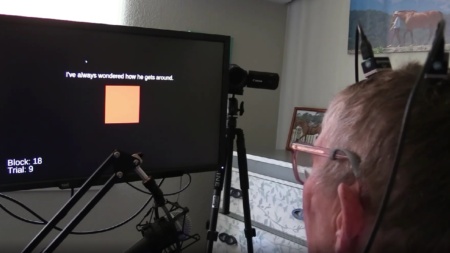
A 67-year-old patient who voluntarily agreed to take part in an experiment at Stanford University was implanted with a brain implant – after which she was able to speak the simplest phrases at a speed of 62 words per minute (three times the previous record).

The woman lost her ability to speak 8 years ago after she was diagnosed with ALS (amyotrophic lateral sclerosis, or Lou Gehrig’s disease). Due to progressive paralysis, she can only make individual sounds and uses a writing board or an iPad to communicate.
Philip Sabes, a researcher at the University of California, San Francisco who was not involved in the project, called the findings a “major breakthrough” and said that experimental brain-reading technology is ready to leave the lab and could soon help paralyzed people partially restore speech.
“The performance reported in the paper reached a level that many non-speaking people would like,” says Sabes.
Text communication, even in the era of keyboards and gadgets with various emojis, remains the fastest form of communication between people. People without speech defects usually speak at about 160 words per minute.
Course
EMPLOYER BRANDING
Build a high-quality and attractive employer brand in just one month.
REGISTER!
The Stanford team’s preprint received additional attention on Twitter due to the death of its co-author Krishna Shenoy from pancreatic cancer. The researcher devoted a significant part of his life to brain interfaces aimed at increasing the speed of communication. In 2019, another volunteer patient Shenoy worked with managed to use his thoughts to type at a speed of 18 words per minute, a record at the time.
The brain-computer interfaces Shenoy’s team is working on use a small pad with sharp electrodes embedded in the motor cortex, the area of the human brain responsible for coordinating, planning and executing voluntary, conscious movements through their connection. This allows researchers to record the activity of several dozen neurons simultaneously and find patterns that reflect the movements that a person is thinking about, even if he is paralyzed (in previous work, volunteers were asked to imagine hand movements).
By “decoding” neural signals in real time, the implants allow a paralyzed person to control a cursor on a screen, select letters on a virtual keyboard, play video games, or even control a robotic arm.
In their new study, the Stanford team wanted to know whether neurons in the motor cortex contain useful information about speech movements. That is, could they determine how the patient tried to move his mouth and vocal cords when he wanted to speak?
These are small, imperceptible movements, and Sabes says the biggest discovery is that just a few neurons contain enough information to allow a computer program to accurately predict what words the patient is trying to say.
The new result builds on previous work by Edward Chang of the University of California, San Francisco, who wrote that language involves the most complex movements that humans make. We push air out, add vibrations that make it audible, and shape it into words with our mouth, lips, and tongue. To pronounce the “f” sound, we put our upper teeth on our lower lip and push out air – this is just one of dozens of mouth movements necessary to speak.
Chang previously used electrodes placed on the top of the brain to allow a volunteer patient to communicate via computer, but the Stanford researchers say their system is more accurate and three to four times faster.
“Our results show a possible way to restore communication in people with paralysis at the speed necessary for conversation,” wrote the researchers, who included Shenoy and neurosurgeon Jamie Henderson.
David Moses, who works with Chang’s team, says the work has achieved “impressive new performance measures.” But even as records continue to be broken, he says, “it’s important to demonstrate consistent and reliable performance over multi-year time scales.” Any commercial brain implant will have a hard time getting regulatory approval, especially if its accuracy and performance decline over time.
Ahead is the development of more complex implants and, apparently, their closer integration with artificial intelligence. The current system already uses several types of machine learning: to improve its accuracy, it used software that predicted which word usually followed in a sentence (for example, that “I” is more often followed by “am” than “ham” even though these words sound similar and can trigger similar patterns in someone’s brain). And this is what increased the speed of the result.
Large language models such as GPT-3 are capable of writing entire essays and answering questions. Connecting them to brain interfaces could allow people using the system to speak even faster simply because the system would better guess what they’re trying to say based on partial information.
“The success of large speech models in the last few years makes me think that a speech prosthesis is within reach, because maybe you don’t need such an impressive signal to transmit speech,” says Sabes.
Shenoy’s group is part of a consortium called BrainGate, which has implanted electrodes into the brains of more than a dozen volunteers. They use an implant called the Utah Array, a rigid metal square with about 100 needle-like electrodes.
Some companies, including Elon Musk’s Neuralink, which develops brain interfaces, and a startup called Paradromics, say they have developed more advanced technologies that can read data from thousands, even tens of thousands, of neurons simultaneously.
Although some skeptics question whether measuring multiple neurons at once will matter, the new report suggests it will, especially if the work involves reading complex brain movements such as speech. The Stanford scientists found that the more neurons they read at once, the fewer errors they made trying to understand what the patient said.
“This suggests that efforts by companies like Neuralink to implant 1,000 electrodes in the brain will make a big difference,” said Sabes, who previously worked as a senior scientist at Neuralink.
Source: Technologyreview




